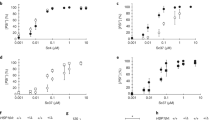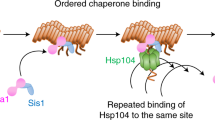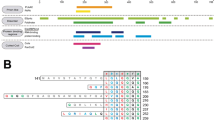Abstract
In a variety of systems, proteins have been linked to processes historically limited to nucleic acids, such as infectivity and inheritance1,2. These atypical proteins, termed prions3, lack sequence homology but are collectively defined by their capacity to adopt multiple physical and therefore functional states in vivo. Newly synthesized prion protein generally adopts the form already present in the cell, and this in vivo folding bias directs the near faithful transmission of the corresponding phenotypic state1,2. Switches between the prion and non-prion phenotypes can occur in vivo2; however, the fate of existing protein during these transitions and its effects on the emergence of new traits remain major unanswered questions. Here, we determine the changes in protein-state that induce phenotypic switching for the yeast prion Sup35/[PSI+]. We show that the prion form does not need to be specified by an alternate misfolding pathway initiated during Sup35 synthesis but instead can be accessed by mature protein. This remodelling of protein from one stable form to another is accompanied by the loss of Sup35 activity, evoking a rapid change in cellular phenotype within a single cell cycle.
This is a preview of subscription content, access via your institution
Access options
Subscribe to this journal
Receive 51 print issues and online access
$199.00 per year
only $3.90 per issue
Buy this article
- Purchase on Springer Link
- Instant access to full article PDF
Prices may be subject to local taxes which are calculated during checkout



Similar content being viewed by others
References
Weissmann, C. The state of the prion. Nature Rev. Microbiol. 2, 861–871 (2004)
Uptain, S. M. & Lindquist, S. Prions as protein-based genetic elements. Annu. Rev. Microbiol. 56, 703–741 (2002)
Prusiner, S. B. Novel proteinaceous infectious particles cause scrapie. Science 216, 136–144 (1982)
Serio, T. R. & Lindquist, S. L. [PSI+]: an epigenetic modulator of translation termination efficiency. Annu. Rev. Cell Dev. Biol. 15, 661–703 (1999)
Patino, M. M., Liu, J. J., Glover, J. R. & Lindquist, S. Support for the prion hypothesis for inheritance of a phenotypic trait in yeast. Science 273, 622–626 (1996)
Paushkin, S. V., Kushnirov, V. V., Smirnov, V. N. & Ter-Avanesyan, M. D. Propagation of the yeast prion-like [PSI+] determinant is mediated by oligomerization of the SUP35-encoded polypeptide chain release factor. EMBO J. 15, 3127–3134 (1996)
Cox, B. [PSI], a cytoplasmic suppressor of super-suppression in yeast. Heredity 20, 505–521 (1965)
Dagkesamanskaya, A. R., Kushnirov, V. V., Paushkin, S. V. & Ter-Avanesyan, M. D. Fusion of glutathione S-transferase with the N-terminus of yeast Sup35p protein inhibits its prion-like properties. Genetika 33, 610–615 (1997)
Glover, J. R. et al. Self-seeded fibers formed by Sup35, the protein determinant of [PSI+], a heritable prion-like factor of S. cerevisiae. Cell 89, 811–819 (1997)
Paushkin, S. V., Kushnirov, V. V., Smirnov, V. N. & Ter-Avanesyan, M. D. In vitro propagation of the prion-like state of yeast Sup35 protein. Science 277, 381–383 (1997)
King, C. Y. et al. Prion-inducing domain 2–114 of yeast Sup35 protein transforms in vitro into amyloid-like filaments. Proc. Natl Acad. Sci. USA 94, 6618–6622 (1997)
Griffith, J. Self-replication and Scrapie. Nature 215, 1043–1044 (1967)
Li, S. J. & Hochstrasser, M. A new protease required for cell-cycle progression in yeast. Nature 398, 246–251 (1999)
Amerik, A. Y. & Hochstrasser, M. Mechanism and function of deubiquitinating enzymes. Biochim. Biophys. Acta 1695, 189–207 (2004)
Finley, D., Bartel, B. & Varshavsky, A. The tails of ubiquitin precursors are ribosomal proteins whose fusion to ubiquitin facilitates ribosome biogenesis. Nature 338, 394–401 (1989)
Johnson, E. S., Schwienhorst, I., Dohmen, R. J. & Blobel, G. The ubiquitin-like protein Smt3p is activated for conjugation to other proteins by an Aos1p/Uba2 heterodimer. EMBO J. 16, 5509–5519 (1997)
Galgoczy, D. J. et al. Genomic dissection of the cell-type-specification circuit in Saccharomyces cerevisiae. Proc. Natl Acad. Sci. USA 101, 18069–18074 (2004)
Chien, P., Weissman, J. S. & DePace, A. H. Emerging principles of conformation-based prion inheritance. Annu. Rev. Biochem. 73, 617–656 (2004)
Borchelt, D. R., Scott, M., Taraboulos, A., Stahl, N. & Prusiner, S. B. Scrapie and cellular prion proteins differ in their kinetics of synthesis and topology in cultured cells. J. Cell Biol. 110, 743–752 (1990)
Borchelt, D. R., Taraboulos, A. & Prusiner, S. B. Evidence for synthesis of scrapie prion proteins in the endocytic pathway. J. Biol. Chem. 267, 16188–16199 (1992)
Caughey, B. & Raymond, G. J. The scrapie-associated form of PrP is made from a cell surface precursor that is both protease- and phospholipase-sensitive. J. Biol. Chem. 266, 18217–18223 (1991)
Frolova, L. et al. Eukaryotic polypeptide chain release factor eRF3 is an eRF1- and ribosome-dependent guanosine triphosphatase. RNA 2, 334–341 (1996)
True, H. L. & Lindquist, S. L. A yeast prion provides a mechanism for genetic variation and phenotypic diversity. Nature 407, 477–483 (2000)
Caughey, B. & Lansbury, P. T. Protofibrils, pores, fibrils and neurodegeneration: separating the responsible protein aggregates from the innocent bystanders. Annu. Rev. Neurosci. 26, 267–298 (2003)
Chernoff, Y. O., Lindquist, S. L., Ono, B., Inge-Vechtomov, S. G. & Liebman, S. W. Role of the chaperone protein Hsp104 in propagation of the yeast prion-like factor [PSI+]. Science 268, 880–884 (1995)
Tuite, M. F., Mundy, C. R. & Cox, B. S. Agents that cause a high frequency of genetic change from [PSI+] to [psi-] in Saccharomyces cerevisiae. Genetics 98, 691–711 (1981)
Song, Y. et al. Role for Hsp70 Chaperone in Saccharomyces cerevisiae Prion Seed Replication. Eukaryot. Cell 4, 289–297 (2005)
Mateus, C. & Avery, S. V. Destabilized green fluorescent protein for monitoring dynamic changes in yeast gene expression with flow cytometry. Yeast 16, 1313–1323 (2000)
Ness, F., Ferreira, P., Cox, B. S. & Tuite, M. F. Guanidine hydrochloride inhibits the generation of prion “seeds” but not prion protein aggregation in yeast. Mol. Cell. Biol. 22, 5593–5605 (2002)
Chen, P., Johnson, P., Sommer, T., Jentsch, S. & Hochstrasser, M. Multiple ubiquitin-conjugating enzymes participate in the in vivo degradation of the yeast MAT alpha 2 repressor. Cell 74, 357–369 (1993)
Acknowledgements
This work is dedicated to the memory of A. Serio, Jr. We thank S. Lindquist, M. Hochstrasser, J. Laney, B. Glick and S. Hanes for reagents and discussions, J. Laney, K. Mowry, A. Jacobson, J. Sedivy, A. Landy, M. McKeown, A. DeLong, M. Strbuncelj, S. Langseth and Z. Zinn for comments on the manuscript, and R. Lesiak and J. Nathanson for graphics assistance. This research was supported by the National Cancer Institute and the Pew Scholars Program in the Biomedical Sciences.
Author information
Authors and Affiliations
Corresponding author
Ethics declarations
Competing interests
Reprints and permissions information is available at npg.nature.com/reprintsandpermissions. The authors declare no competing financial interests.
Supplementary information
Supplementary Video S1
Movie of Sup35-GFP in a [psi-] X [PSI+] zygote isolated in Fig. 2a. (MOV 284 kb)
Supplementary Video S2
Movie of Sup35-GFP in a [psi-] X [psi-] zygote isolated in Fig. 2b. (MOV 241 kb)
Supplementary Video S3
Movie of Sup35-GFP in a [psi-] X [PSI+] zygote isolated in Fig. 2c. (MOV 73 kb)
Supplementary Figure Legends
Legends to accompany the below Supplementary Figures. (DOC 71 kb)
Supplementary Figure S1
Unprocessed Gst-Sup35 fusions cannot propagate the prion state. (JPG 79 kb)
Supplementary Figure S2
Sup35[PSI+] and Sup35[psi-] are equally stable and long-lived. (JPG 17 kb)
Supplementary Figure S3
Protein profiles in transient tag strains. (JPG 27 kb)
Supplementary Figure S4
PMFA1 is rapidly repressed in diploids upon mating. (JPG 58 kb)
Supplementary Figure S5
Sup35-GFP functionally replaces Sup35 and acts independently as a prion. (JPG 32 kb)
Supplementary Figure S6
Confirmation of [PSI] state of zygotes. (JPG 76 kb)
Supplementary Figure S7
Sup35-GFP maturation half-time. (JPG 17 kb)
Supplementary Figure S8
Fluorescence pattern confirms mating in phenotypic switch experiments. (JPG 36 kb)
Supplementary Figure S9
Single cell reporter for stop codon read-through. (JPG 22 kb)
Supplementary Figure S10
Confirmation of [PSI] state of zygotes. (JPG 71 kb)
Rights and permissions
About this article
Cite this article
Satpute-Krishnan, P., Serio, T. Prion protein remodelling confers an immediate phenotypic switch. Nature 437, 262–265 (2005). https://doi.org/10.1038/nature03981
Received:
Accepted:
Issue Date:
DOI: https://doi.org/10.1038/nature03981
This article is cited by
-
Protein assembly systems in natural and synthetic biology
BMC Biology (2020)
-
Nucleation seed size determines amyloid clearance and establishes a barrier to prion appearance in yeast
Nature Structural & Molecular Biology (2020)
-
Loss of amino-terminal acetylation suppresses a prion phenotype by modulating global protein folding
Nature Communications (2014)
-
Amyloid-associated activity contributes to the severity and toxicity of a prion phenotype
Nature Communications (2014)
-
Dominant prion mutants induce curing through pathways that promote chaperone-mediated disaggregation
Nature Structural & Molecular Biology (2011)
Comments
By submitting a comment you agree to abide by our Terms and Community Guidelines. If you find something abusive or that does not comply with our terms or guidelines please flag it as inappropriate.



